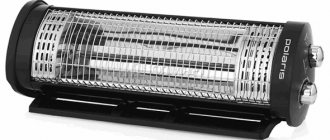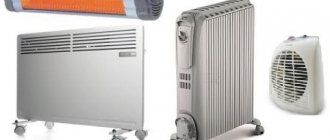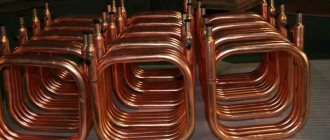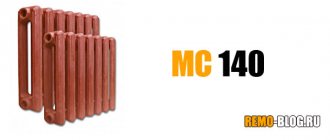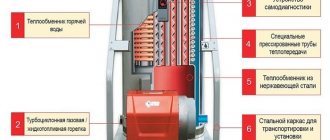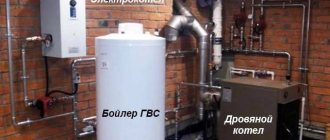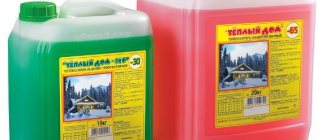Warmth is the main joy in the cold season
Radiators - accumulate thermal energy received from the coolant, and then release it into the surrounding air.
You should approach this issue carefully: familiarize yourself with all possible market offers, choose the optimal price-quality ratio
It is necessary to take into account the layout and purpose of the room, the time people spend in the room with the heating device, as well as the location of the heater installation
To make the task easier, we will introduce you to the most popular and inexpensive heating options, namely convectors and radiators. The devices have stood the test of time and rightfully occupy a leading position among heaters. Let's consider the general characteristics of these heating devices, the principle of operation, as well as the pros and cons of each option. Let's try to determine what is better, more profitable and more reliable. Before we start choosing a heating device, let’s figure out how a radiator differs from a convector.
Heating devices - brief description
Radiator - serves to heat the room, operates on the principle of circulating water or antifreeze, in other words, it emits infrared radiation. As a rule, it is installed under the window, as it creates a “thermal plug” that does not let the cold into the room. A radiator is a structure consisting of several sections or panels, on which the amount of incoming heat and heat transfer depend. Previously, cast iron batteries were considered common, but progress has led to the widespread replacement of cast iron with aluminum.
A convector is a heating device that operates on the principle of convection: under the influence of a heating element, hot air is forced into the room, and cold air takes its place. That is, convection devices thoroughly mix the air layers of the room, thus creating the effect of a fan heater. This device consists of plates that pass air flows through them due to temperature differences, as well as channels, which are a key element, since the coolant passes through them. When using it, the heating of the air is 70-75%.
Disadvantages and advantages of heating devices, their differences
First of all, the difference between a convector and a radiator is the type of design and ribbing of the pipes, which significantly increases heat transfer. In addition, copper and aluminum are used in the manufacture of heating elements, which prevents metal corrosion. To operate the device, you need from 0.5 to 1 liter of water, which significantly saves energy costs. Light weight and simple design ensure ease of installation.
It is known that radiators are more efficient in terms of heat transfer. Compared to convector heaters, heating the radiator uses almost the entire area, which ensures constant heating of the room. Another advantage of radiator devices is their power and environmental friendliness, namely, air purity.
Convector disadvantages:
- lead to the formation of drafts in the room due to air movement from bottom to top;
- design features lead to the accumulation of dirt;
- Due to the peculiarities of the operating principle - convection, dust is constantly chasing around the room.
Radiator cons:
How convector heaters are designed and how they work
Before we talk about all the pros and cons of convector heaters, it is necessary to thoroughly study their design. They consist of the following parts:
- Heating element - it is equipped with fins of a large area, providing heating of air masses;
- Control system - it can be electronic or mechanical, ensuring operation in certain modes and controlling the temperature;
- The case protects all the insides.
The design of the equipment is extremely simple, and this is more of a plus than a minus.
Warm air tends upward, and cold air fills its place - this is the principle of convection.
Let's see how a convection heater works. When you turn it on, the heating element starts working. It heats the air, as a result of which its density decreases - becoming lighter, it rises to the ceiling and removes cold air masses from there. Cold air goes down and is sucked into the convector. Some time after turning on the equipment, a stable air circulation is created in the room , ensuring the creation of a comfortable atmosphere.
The temperature regime is monitored automatically - it turns off the convector heater when the set temperature is reached, and turns it on as soon as the rooms become cooler. Automation can be electronic or mechanical. Electronics are more accurate, they save energy and provide the equipment with many additional functions. As for the “mechanics”, it is simpler, but less economical.
An electronically controlled convection heater will cost more than its counterpart with a mechanical thermostat - but the presence of electronics is considered a plus.
Operating principle of an oil cooler
Everything here is arranged quite simply. The oil cooler is a hermetically sealed reservoir filled with mineral oil. An electric heater is also located inside the structure. As a result of the operation of the heating element, the oil temperature rises, and then the walls of the tank heat up. The room is heated.
To prevent the oil from boiling, the system is equipped with a special sensor that controls the temperature. In addition, some models have horizontal control. This means that if the radiator accidentally tips over and the heating element is out of the oil environment, the automation will instantly turn off the device.
Oil radiators are very easy to use. No knowledge is required here. You just need to plug the plug into the outlet, press the power button and move the device closer. Some manufacturers equip their models with a timer that allows the device to automatically turn on at a certain time. This is very convenient if you want, for example, to return from work to an already well-warmed room. At the same time, the radiator remains turned off throughout the day and does not waste electricity.
What heats better, a convector or an oil radiator?
Significant differences in the operation of a convector from an oil radiator affect the thermal characteristics and thermal efficiency of the devices.
Thermal characteristics of oil radiators
The main advantage of an oil heater over an electric convector is its high heating temperature. If the radiator design has a fan heater, the room can be warmed up quickly enough.
The heater operates almost silently. The optimal solution would be to use a heating device in country houses. Maximum heating area 20-25 m².
Thermal efficiency of convectors
The convector is distinguished by a low heating temperature, no more than 60°C, creating a favorable microclimate. The device does not dry the air, but to warm up the room it will take longer than an oil radiator with a fan heater, but only if the heating element of the latter is heated to the required temperature. The performance of convectors is sufficient to provide heating of a room over 100 m².
The electric convector is distinguished by the best thermal characteristics and performance.
Video description
In this video, the master talks about the difficulties and problems that can be encountered when installing a water convector with water heating:
terms of Use
For dry rooms, you can choose any convector heater. For a kitchen or bathroom, it is necessary to consider the degree of protection of the heating element and control unit in the case of electrical equipment. In addition, it is necessary to take into account the heating temperature of the housing in order to prevent the occurrence of burns or fire of surrounding objects and decorative trim.
The second point can be eliminated using devices that are equipped with an automatic overheating sensor. It turns the equipment off and on when the set temperature thresholds are reached. Another solution is to install a thermostat. This device allows you to independently adjust the heat output of a convection heater.
Convector with thermostat Source elektro-teh.com
Power and efficiency
For a temperate climate in Soviet times, calculations were made. As a result, even today it is believed that 1 kW of energy must be taken into account per 10 square meters of area. It is worth noting that such a guideline is relevant for a house in which there is practically no heat loss; the ceiling height is limited to 2.7 meters. That is, for constant convector heating of dilapidated housing or with high ceilings, you need to increase the power. The additional heat source can be selected with a lower value relative to the reference.
The efficiency of radiators depends not only on the design of the basic components and its power. Additionally, the unit can be equipped with a fan. It provides forced movement of heated air, which speeds up the process of warming the space in the room.
Convection principle
Convector radiators operate from various energy sources. But the principle of their operation is the same. The air heated by the convector rises, and the cold masses fall down. The same process occurs in nature. At the same time, cyclones and winds are formed.
Heated air currents rush to the ceiling in the room, as they are lighter. Cold masses are determined near the floor. This movement occurs naturally. Some devices provide additional ventilation, which speeds up heat exchange processes.
But a conventional convector battery independently circulates air masses in the room. This is a simple but reliable way to heat your home quickly and with minimal energy costs.
Convection heaters
Now we will answer the question of what a convector type heater is. A convector is a device that uses convection, in most cases natural, in its operation. The basis of the design of each device is:
- Housing - it is designed to protect people from accidental contact with live or hot parts. It also plays a decorative role. The body contains controls, indicators and information screens;
- Heating element – in convection heaters it can be electric, gas or water. It is he who is responsible for heating the air in the rooms;
- Thermostat - it can have a very different design.
All convection heaters are extremely simple, there is nothing complicated or supernatural about them . Thanks to this, they have earned such popularity.
The convector design is distinguished by its simplicity, and this is a sure sign of reliability.
They work very simply - when you turn on the gas, supply hot coolant or electricity, the ribbed heating element heats up, which begins to warm up the air. Air masses become lighter as they travel upward. This process is closely monitored by automation that regulates heating. At the same time, cold air enters the convectors, which envelops the heating element - the cycle repeats.
As soon as the air temperature sensor sees that the heating level has reached the specified limit, it will give a command to turn off the heating element. As soon as the air cools below the set norm, the thermostat will work and give a command to activate the device. Thus, convectors ensure the maintenance of stable air temperature in the premises.
In water convectors, temperature control is carried out using a special thermostatic valve-regulator.
Features of the convector heating system
The operating principle of convector heating
The very first convector heating batteries were traditional stoves. Thermal energy from their surface is transferred to the room. In this case, natural convection of air flows occurs - with a higher temperature they rise upward, creating heat circulation.
However, the efficiency of their work remains extremely low - the efficiency indicator did not exceed 25-30%. Therefore, convector heating boilers have been developed that transfer energy more efficiently. For this purpose, their design includes additional convector surfaces that improve circulation and, accordingly, the heating rate of the house.
How does convector heating at home differ from conventional heating?
- No pipelines. This reduces the primary costs of organizing heating;
- Possibility of installing local heating points - autonomous radiators. Most often this is done for dachas or houses with a small area, or apartments;
- Operational regulation of energy consumption to optimize temperature conditions.
The disadvantages of such a system include the complexity of the organization for buildings with a large area. Even if you install convector water heating consisting of autonomous radiators, it is problematic to create a single control unit. But there are exceptions - modern gas convector heating boilers. These are common models that can be installed in piping systems. The parameters for choosing such boilers are the same as when designing traditional heating systems.
The amount of energy generated in convector-type heating devices directly depends on the area of the heat exchanger
This is what you need to pay attention to first.
Types of convectors
Depending on what coolant is supplied to the heating system, you can choose a water or gas convector. The internal structure of the devices will be slightly different, but the principle is the same: the coolant heats the elements inside the device, through which air passes and picks up heat, then leaves the heater and warms the room.
Gas
Gas convector heater
Inside the convector there is a burner that heats the gas. The device has an air intake, one end of which is located outside. Oxygen is needed to support combustion. A chimney is needed to remove combustion products from the combustion chamber.
Gas convector heating at home does not require water, it is safe, since the combustion chamber is completely insulated.
The disadvantages of gas appliances are as follows:
- To install a convector, you need to obtain permission from the gas industry. The problem may arise due to the design of the house and the impossibility of installing a chimney.
- When heated with gas, the body temperature is above 60 degrees, so the process of thermal decomposition of dust particles begins, which settle on furniture and other interior items.
It is more profitable to use gas convectors in rooms that are not intended for permanent residence or as additional heating.
Mermen
Water heating convector
Water convectors can be installed in autonomous and central heating systems. They are reliable and durable, and are also capable of transferring up to 95% of the generated heat.
According to the type of installation, water heaters can be in-floor, baseboard, wall, floor, or basement. They are connected to pipes of any diameter through a series of adapters. The case temperature usually does not exceed 30 degrees, so small children cannot get burned by touching the device.
Water heating convectors built into the floor are planned at the stage of building a house, as niches are built under them and pipes are supplied. Once the floor is poured, it will be impossible to install such models.
Wall-mounted water heating convectors are usually placed under windows to reduce the flow of cold air if the double-glazed window is single-chamber.
If you need to hide the heating system, you can buy built-in models. They are mounted in special niches in the wall or mounted on furniture.
Among the advantages:
- Light weight, which allows you to install devices on plasterboard partitions.
- Compact due to slim body.
- You can customize and regulate the temperature.
- There are models with one or two heat exchangers.
Water heaters are the most common among similar models, therefore they are available in various designs, which allows them to be installed in rooms of any style and color scheme.
Electrical
Electric floor convector heater
Electric convectors are considered the safest. Most manufacturers produce devices with the highest degree of electrical protection: not a single wire comes into contact with the housing. Thanks to this, the models can be operated without grounding.
The water heating temperatures are low enough so that oxygen does not burn and dust does not break down into microparticles that have a bad effect on the state of the human respiratory system. Low heating temperatures are compensated by the volume of heating elements.
Any heater consumes fuel. In this case, it is electricity, for which you do not need to go or travel far, such as for firewood or gasoline. Electricity consumption can be high if the premises are rather large in size or if the temperature in the winter season drops significantly below zero degrees. To save money, it is advisable to install double-glazed windows with argon coating, which prevents heat from escaping.
Infrared
Convection infrared heater
If a typical convector heats the air by circulating it through a heat exchanger, then the principle of infrared heating of a house with convectors is different. The device heats surrounding objects using infrared radiation, and the objects give off heat to the surrounding space. In this regard, it is desirable that the device be installed in a place where its radiation on objects or walls will be maximum. Then the heat transfer will be high.
It is better to use infrared heaters as an additional source of heat, since when turned off, the room quickly cools down.
There are only two models of heaters in the infrared series - floor and wall. They require a working outlet with high-quality wiring. It is not advisable to use extension cords if the appliance will be operating at full power.
Oil type heaters
These devices are very widely used to increase the air temperature in an apartment or house. Installing them is extremely simple; no special skills or knowledge are required. Plug the device into the outlet, placing it closer to the heated area - and you're done. Thanks to the simplest possible design, breakdowns of the device's electrical circuit are unlikely.
Several models of oil radiators - the one on the far left is equipped with a fan.
The design of the oil cooler is based on a metal reservoir with mineral oil poured inside it. The oil, in turn, contains a heating element. As a rule, a device of this type is equipped with a rheostat for temperature control, a compartment for the power cord and electrical protection against overheating. Sometimes the heater also has a sensor that detects deviation from the horizontal. This allows you to automatically turn off a device that has tipped over. Oil radiators are also splash-proof.
Oil radiators are equipped with a handle for easy movement around the apartment.
The heaters are equipped with swivel wheels.
The cord compartment is designed to store the power cable when not in use.
Advantages of the oil device:
- Low price;
- Quiet operation;
- Ease of movement over various distances, for example, from room to room.
To determine how much power the device will need to make the room warm, we will use the following rule. If the ceiling height does not exceed three meters, then to heat 10 square meters of space you need a radiator with a capacity of 1 kilowatt. Basically, similar devices are produced with a power range from 1 to 2.5 kilowatts.
The device usually has a thermostat that automatically sets the desired temperature, maintaining it at the same level. Models equipped with a timer are very convenient - it will turn on the heater at the appointed hour. For example, you can schedule heating for the morning or evening, when all household members arrive from work. Thus, the timer allows you to save a fair amount of electricity, which is very expensive today.
Heater with electronic control system.
Mechanical control system.
Convector heaters: types and features
Electric convector heaters come in floor, wall and baseboard types. Floor and wall convectors are usually up to 45 cm high, but baseboard convectors are usually no higher than 25 cm, but much longer - the length of such a convector can reach 2.5 m.
Floor plinth electric convector
Electric convector heaters are installed on the floor or wall. The choice of its type depends on where you want to place the device. If you want to place a heater under a window opening, take a closer look at baseboard convectors. They can be moved from place to place using a handle and wheels. Due to its length, frequent movement of the baseboard convector is not always convenient, but you can be sure that the air in the lower part of the room will be well heated, and this is especially important when sitting at a computer and on a cold parquet floor.
If you want the unit not to take up space in the room, convector-type wall heaters are suitable for you. This heater is mounted on the wall using special brackets, is compact and fits organically into a modern interior.
What to look for when buying an electric wall convector with a thermostat A good convector will serve you for many years, so you should take your purchase seriously and choose a quality device. The following characteristics are important:
- power. The choice of this parameter depends on the size of the room. For example, the area of your room is 19 m², the ceiling height is 2.7 m. To heat 1 m³ of room, 25 W of power is required. Thus, we multiply both numbers by 25 and get 1285.5 W. When rounded up, we get one and a half kilowatts - this is the heater power we need;
Helpful advice! The calculation of 25 W of power for heating 1 m³ of area is correct if you intend to use a convector to heat your house in the off-season, while the heating has already been turned off or has not yet been turned on. If there is no heating in the room at all, calculate based on 40 W of power per 1 m³.
- heating element and its type. A cast monolithic heater operates longest and most efficiently;
For heating efficiency, you need to choose a convector with the power for your room
- dimensions. Altitude affects the speed of air movement. As a result, a small convector 60 cm high will warm the room much faster than a tall one. If you choose a floor or baseboard heater, pay attention to its weight - after all, you may want to move it from place to place, or one day the convector heater will need to be repaired and you will need to take it to a technician;
- safety to use. It is clear that everyone strives to choose the most secure device. In the case of a convector, you only need to worry about the absence of sharp corners on the unit. After all, one of the main advantages of convectors in the question of which is better, heaters or convector systems, is that the convector has no risk of ignition. It will not burn the skin if accidentally touched, as it heats up to a maximum of 60°C, does not require grounding and copes with voltage surges;
- additional options. When purchasing a convector-type heater, which has useful capabilities in addition to directly maintaining the desired temperature in the room, you will be able to control its operating mode.
| Function | How to use |
| Temperature regulator | You can always maintain a comfortable temperature in the room. In cold weather, you can turn the regulator to maximum, and in warm weather, reduce the temperature. |
| Thermostat | Allows you to constantly maintain a set comfortable temperature in the room. |
| Timer | Allows you to turn on the heater and set the time for its automatic shutdown. Thus, you can put the convector on heating and go to bed. |
| Ionizer | Absorbs dust and saturates the air with negative ions. The microclimate in the room becomes healthier, and you sleep better and become more productive. |
| Remote control | Allows you to turn on the heater from a distance. |
| On timer | Allows you to set the time to turn on the device in advance. This is especially true on cold winter mornings, when you want to crawl out from under the blankets into an already warmed room. |
| Rollover protection | It will help to avoid troubles if there are small children and pets in the house. |
Helpful advice! If people with respiratory diseases or allergies live or work in the room where the convector will be installed, take care to choose a heater with the function of humidifying and ionizing the air.
Radiators and gas convectors
If spot heating devices are sufficient to maintain the temperature in the room, it is recommended to install gas or electric convector-type heating. They consist of a heating element, a control unit and a combustion product removal system (gas models).
Electric heating convectors
Electric convector design
This is the easiest and fastest way to heat a house or apartment. The heating element is an electric heating element, the temperature of which is transferred to the body of the device. Using a system of slots, air freely penetrates inside the radiator, creating convection.
The most common models for convector heating systems have a tubular heating element with metal plates. This increases the heating area. But reviews talk about one drawback - extraneous sounds are heard during operation. The reason for this is the expansion of the metal of the plates.
To install convector heating batteries, the following conditions must be met:
- The cross-section of the electrical wiring must be designed for the maximum power of the device;
- It is recommended to install a separate RCD to prevent short circuits;
- According to safety rules, you cannot leave the convector on when no one is in the house.
You also need to take into account high energy costs. Therefore, if there is a gas main, convector heating radiators with a burner are chosen.
The cost of electric convectors ranges from 4,000 to 15,000 rubles
It is important to pay attention to the characteristics of the control unit, protection from water and the presence of automatic shutdown when tipping over
Gas heating convectors
Economical heating of a convector-type house can be done by installing gas models. They consist of a burner that is not located indoors. Air flow and combustion products removal are carried out through a coaxial chimney.
Unlike convectors for electric heating, gas models have large dimensions. This is due to the presence of a gas burner and a fairly large heat exchanger. To improve convection, some models install a fan to increase air exchange.
The average cost of gas convectors is 8000-12000 thousand rubles. Despite the large number of foreign brands, they prefer to purchase domestic analogues. They are better adapted to special operating conditions.
In what cases is the installation of convector heating at home justified? Reviews about it, the high cost of batteries and radiators indicate a balanced approach when choosing such a system. In most cases, it is relevant for small rooms and production workshops where it is necessary to provide zonal (selective) heating.
In the video you can familiarize yourself with the installation features of gas convectors:
How to buy the best convector heater: types of convectors
The most popular type of convector is electric, but there are several types of this equipment. Convective-infrared are distinguished by the principle of heating: they act on objects - walls, furniture, floors. By maintaining a comfortable temperature and humidity level, the air does not dry out, which creates a healthy microclimate in the room. A significant disadvantage of such a convector is its high cost.
Convection Infrared Heater
Film wall convectors, consisting of an electrically insulating film and a heating element, can be easily hung on the wall or removed and rolled up. They are very effective, but extremely short-lived. The service life of such a device is up to 3 years.
Gas ones effectively warm up even more rooms, are simple and safe to use, environmentally friendly and convenient. However, for such a convector to operate, it requires a gas source, as well as a connection to a chimney or hood, which significantly narrows the scope of application of this equipment.
The operating principle of water convectors is based on a central heating system. Such a heater can be floor-mounted, wall-mounted, or even built under the floor or into the walls. Such a convector is safe, convenient and durable, but it is capable of heating an area of up to 10 m², and the warm air from such a device is distributed unevenly. Therefore, most often this type of convectors is used in swimming pools and small rooms with a large glazing area.
Floor convectors powered by central heating
Helpful advice! To choose the type of convector that suits you without overpayments, determine the scope of use of the heater. If your goals do not include systematic heating of a large house or heating a swimming pool, there is no point in installing a gas heater or building in a water facade heater - just get an electric one.
Types of heating elements of electric heating convectors with a thermostat The heating element is the most important part of the convector, because it determines how effectively your apartment or office will be heated. There are several types of heating elements:
- ribbon or needle-shaped. Such a heating element is a narrow dielectric plate with loops made of a nickel and chromium alloy on both sides. The main disadvantage of this design is the fragility of these hinges. Due to the ease of damage, tape heating elements are almost never used by modern manufacturers. In addition, this design does not provide for the presence of fins; as a result, the convector body heats up first, followed by the movement of warm air. This heating principle is not fast or efficient;
- tubular heating element - heating element. This is the most popular type of convector heaters for home and office use. Its design is simple: there are aluminum fins along the entire length of the heater tube. The heat transfer of the device is directly proportional to the size and frequency of the fins;
| Advantages of heating elements | Disadvantages of heating elements |
| Much lower temperature of the tube compared to the nichrome thread inside it. | The difference in temperature expansion between the aluminum plates and the steel tube causes a slight cracking sound that accompanies the operation of the device. |
| Long service life. Uninterrupted operation in rooms with high humidity - in this case, protection class IP24 is relevant. | As the device operates, the space between the fins and the steel tube increases, which leads to heat loss. |
- monolithic heating element. Basically, it is similar to a heating element: there is a nichrome thread in a cast aluminum body, and heat transfer is provided by ribs on the body. But a dielectric backfill is used as an insulator. Thus, the difference in temperature expansion, leading to heat loss in the heating element, is leveled out. As a result, the efficiency of the monolithic heating element is maximum. The body of the device of such a convector hardly heats up, and the operation is quiet. The principle of operation of the unit is as follows: the hollow body acts as a wind tunnel; as the air heats up, thrust is created in it. As a result, cold air continuously enters the switched-on convector, is converted into hot air and flows upward, and all the air in the room is systematically warmed up.
Helpful advice! When purchasing a wall-mounted convector heater, be sure to inquire about the type of heating element. This way you can predict in advance the effectiveness of its operation and possible problems.
Difference between convection heater and radiator
The heating system only reminds itself with the arrival of cold weather. However, you need to prepare the sled in the summer. During the cold season, comfort indoors, be it a house, apartment or office, is vital. Heat supply is a serious issue, especially in the choice of radiators.
Designation
A heating device is a radiator in the middle of which a coolant (water, antifreeze) moves. The heating device returns heat to the room using infrared, in other words thermal, radiation. Heating of the room occurs from the window into the room. According to their design, heating devices are sectional, tubular and panel. The level of heating of the room depends on the number of attached sections or panels. Today, our usual cast iron sectional heating devices are being replaced with metal or bimetallic devices.
The material from which the radiator is made plays an important role in heat transfer
Heating device
The radiator design is a radiator that transfers heat using convection. Convection is a physical phenomenon in which air flows through the heater, increases in volume and enters the space of the room, while cooler air occupies the free space. Air circulation occurs in a real way, creating a temperature difference. In the design of a convector heater, the important elements are: a channel through which the coolant moves, and grates or plates through which air passes.
Radiator design to contents ^
When comparing heating devices and convector heaters, let’s turn our attention to the places of their use. So, for example, water heating radiators are perfect for office and industrial premises with an increased glazing area, and also with a very high level of moisture (greenhouses, semi-houses, semi-gardens, swimming pools)
Panel radiators made of steel are very often installed in cottages and cottages. To heat apartments in houses with centralized heating, today it is proposed to install bimetal radiators.
It is believed that in terms of heat output, heating devices give off more heat than convector heaters. This is due to the surface area, which is involved in the heat transfer process. Heating devices provide more constant heating of the air, and convector heaters can create a draft in the room. This phenomenon occurs due to the movement of air from bottom to top. And if the device does not cover the width of the window, then the air also moves from the window into the room. From a safety point of view, convector heaters are considered less hot than, say, a cast iron radiator. But due to the properties of the structure, dust collects in the design radiators.
Conclusions TheDifference.ru
- The heating device has a very high heat output;
- The heating device is more economical to operate; the radiator design requires more heat input;
- A heating device will cost much more than a radiator design;
- The heating device is more environmentally friendly, the design of the radiator collects and drives away dust;
- The heating device is more powerful and larger; the radiator design is more compact and can be built into walls and floors.
Pros and cons of convector heaters
Convectors quickly warm up the room. Most of them operate silently, and the efficiency of particularly efficient models reaches 99%. The warranty period for convectors is 10 years, while often the service life of the heater is 20-30 years. Convectors are completely safe to use, and it is easy to find a good price for a convector heater.
Convector-type electric heaters are economical to use
It is worth considering that a convector is good for heating a small room. Over time, its speed and heating power drop, and during operation the heater dries the air and raises fine dust. Also remember that running a convection heater requires energy, although some models can reduce electricity consumption and help you save money.
Helpful advice! If you plan to use the convector throughout the cold season, it makes sense to install it on the wall. If you take out the device only during cold weather, it is better to give preference to a floor convector on wheels.
Comparative table of technical characteristics of oil and covector heaters
| Options | Oil heater | Convector heater |
| Economical | - Low economical. | +Approximately 25% more economical. |
| Heating time | + - Conventional models heat up for a long time, but those equipped with fans quickly. | —Heats the room for a long time. |
| Comfort to use | -Average. | +Both floor and wall models are more convenient. |
| Safety | —High surface temperature (but there are models with a protective casing); If the operating rules are violated, there is a risk of explosion. | +The surface of the convector is not subjected to strong heating; can be left unattended. |
| Life time | -Average | +Big |
| Environmental friendliness | —Due to convection, it raises dust particles | —Due to convection, it raises dust particles |
And based on the totality of all this, when deciding whether to choose a convector or an oil heater, you can clearly conclude: of course, a convector. Lightweight, compact, silent and safe, these heating devices are gradually replacing heavy, short-lived devices filled with hot oil from apartments and offices. So we can say that oil heaters have almost become a thing of the past in the matter of heating rooms. The only thing is that models of oil heaters equipped with fans are able to heat the room somewhat faster, but the process of heating its surface itself remains long. See below for detailed materials on choosing these heaters.
(no votes yet)
Types of convector heaters
Convection type heaters can be:
- Electrical.
- Mermen.
- Gas.
- Film.
- Convector-infrared.
Convector device diagram
Electric heaters are inexpensive. They are very easy to install and use. However, heating with electricity is always more expensive than any other methods (gas, wood, coal, etc.), convectors are no exception. When purchasing a device, you need to be prepared for increased electricity costs.
Such devices are not very suitable for large areas, and over time the heating speed and power may decrease.
Only a device with automatic overheating protection can be considered fireproof. The thermostat will help you avoid unnecessary expenses.
Water convectors. It is clear that the coolant in a convector heater is water. The heater can be in-floor or similar to a regular radiator. The latter are attached to the wall and connected to the central heating. Such a device requires little electricity. The light weight of the device allows it to be mounted on a plasterboard wall.
Gas. The availability of fuel makes this convector the most economical of all. It can be used not as an additional, but as the main method of heating.
The design can be floor or wall mounted. It can be connected to the main gas and to a cylinder. But there is enough hassle with a gas convector heater.
First, you need a chimney. Secondly, you need to connect and use such a device with extreme caution. And it costs much more than previous models.
Film convectors are a new product among heaters. This is a two-layer electrical insulating film with heating elements placed in it. They easily hang on the wall, do not spoil the appearance of the room, and after use they are simply rolled up and put away. Warranty – 3 years.
Convector-infrared heaters combine two technologies. But although the device is effective, its price is still unreasonably high.
Energy-saving home heaters will help you keep warm in winter without paying a lot of money for heating. Find out what causes energy saving and what types of economical heaters exist.
Read about how to assemble a long-burning stove with your own hands in the following article.
Do you want to save on buying a gas boiler? Then Russian-made boilers are your choice. Here https://microklimat.pro/otopitelnoe-oborudovanie/kotly/gazovye-rossijskogo-proizvodstva.html you will find out which models are worth purchasing and what are the advantages of our devices.
